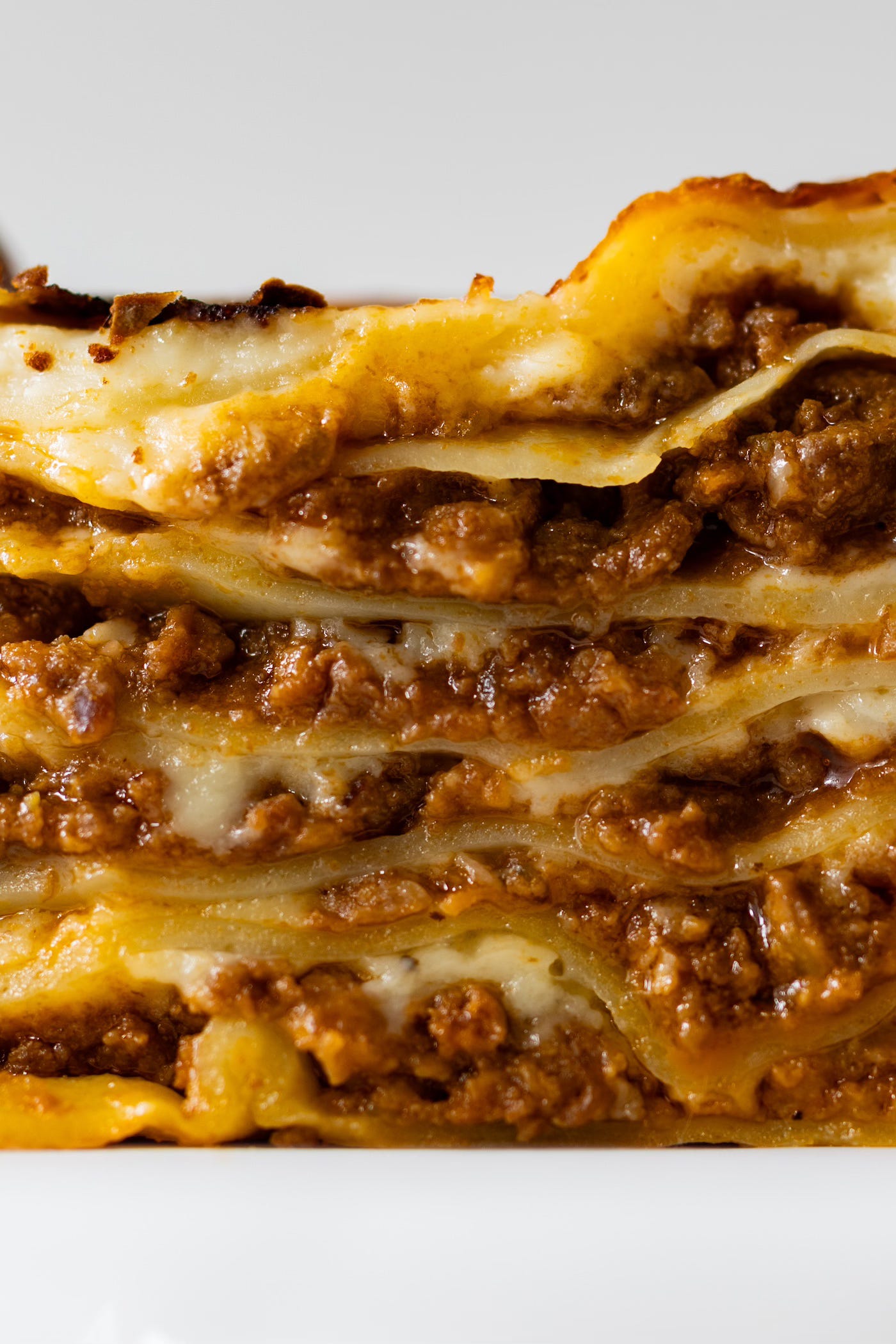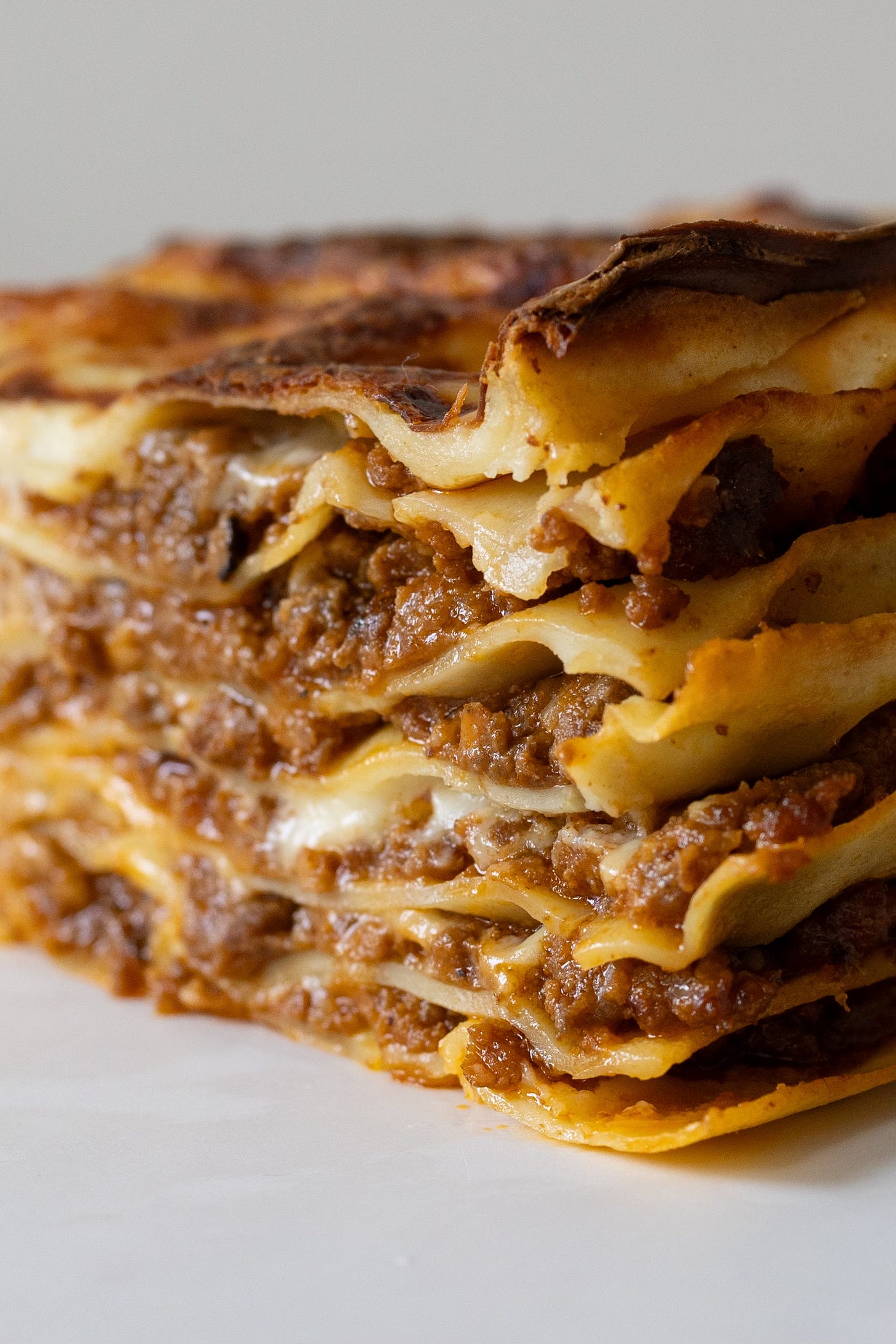Garfield the cat was my first role model. He hated Mondays, loved coffee, fell asleep in sunbeams and, being born in the kitchen of Mamma Leoni’s Italian Restaurant, was obsessed with lasagna*. And I ate loads of it growing up, mostly at other peoples’ houses and large gatherings, and mostly following the same blueprint: intense layers of beefy mince, swimming in rivers of white sauce between thick sheets of green pasta, topped with cheddar cheese (sometimes a few slices of tomato!) and browned and bubbled under a hot grill. At the time, irresistible.
It came as a surprise to discover that, according to the official recipe and method for Lasagne Verdi alla Bolognese, as lodged and filed with the Accademia Italiana di Cucina (Italian Kitchen Academy), the basic principles were not far off, all the way down to spinach-coloured pasta sheets. But that’s a recent revelation, the latest on a multi-layered lasagne love affair that is more passionate than ever. Because, although I could never claim to have the best method, what I put in the oven right now is my best ever and I can’t imagine how to improve on it. I hold it back for special moments and the right guests: people who appreciate the magic that happens when simplicity, ingredients, technique and time all overlap in a Venn diagram of deliciousness.
*PS. in Italian, lasagna is singular and refers to a single sheet of pasta, as opposed to lasagne, which is the actual dish. It’s only in America that they call the dish lasagna. Go figure.
Ragù
As with many things Italian, the idea of layered pasta crops up all over the boot in many forms and guises, but for me, the one from up north, made with Ragù alla Bolognese, is the classic and it calls for a blend of beef and pancetta, or pork. When you start doing that, things go up a level. Pancetta adds a punchy flavour that is amazing with a Tag Bol, but for lasagne, I actually prefer using pork mince and in recent times, have discovered a great pork sausage mince made by my local butcher. It has nothing other than pork in it , but somehow the ratio of fat is ideal for a ragù. Quantities? Don’t ever be afraid of having leftover ragù. A tub of frozen pasta sauce is like money in the bank.
The pasta
For the full effect, you have to make your own fresh egg pasta. It’s the only way to get the sheets really thin, which is one of the secrets to a really great lasagne. And great lasagne is surprisingly light: more a delicate layer of leaves rather than a béchamel swamp. While the official version calls for a pasta made with pureed spinach, I make regular sheets because I prefer the aesthetic.
The béchamel
Your béchamel should be a thick pouring cream consistency allowing you to drizzle it over each layer in moderation. The aim is a sophisticated blend of ragù, sauce and Parmigiano that creates light, distinct layers and a sturdy structure. All in all, my perfect lasagne is quite a lot ‘drier’ than you might imagine. As Giorgio Locatelli says in Made in Italy, kids in Italy will cry if you give them lasagne that doesn’t stand up straight on the plate. And the official recipe ends with the phrase: le porzioni nel piatto devono risultare rigorosamente ‘in piedi’. Translation: the portions on the plate must be strictly ‘standing’.
Attenzione!
It’s worth noting that while the official updated Academia recipe now includes multiple variations and additions, there are a few things that fall under the heading of ‘unacceptable variants’, including herbs of any sort, brandy and, interestingly, garlic, to which I would have to plead guilty. But let’s leave that for now to keep the peace. Of all the banished additions, the most important is definitely smoked pancetta or bacon of any sort. Avoid it at all costs. No matter what you do, it will either dominate or linger.
The full method for this lasagne follows below and there’s a veggie-forward sequel in the oven, so keep a look out for that in an upcoming post.







